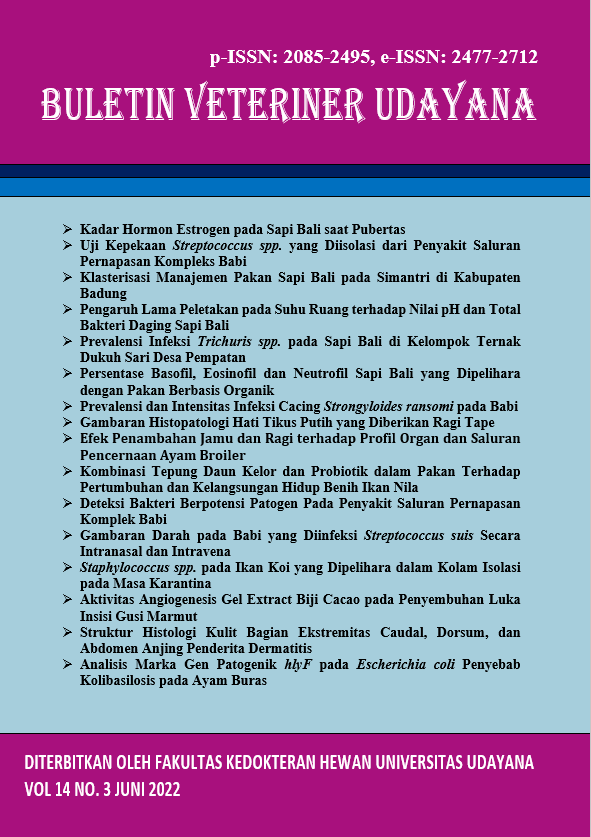ANALYSIS OF PATHOGENIC GENE MARKER hlyF IN ESCHERICHIA COLI CAUSES OF COLLIBACILLOSIS IN FREE-RANGE CHICKEN
Abstract
Colibacillosis by Avian Pathogenic Escherchia coli (APEC) is an infectious disease in poultry. The ability of APEC to cause disease depends on various virulence factors, including hlyF. The study aimed to prove the existence of the APEC hlyF gene in Bali and to find out the DNA sequences of these hlyF genes and their kinship with the hlyF gene from other countries. This study used two APEC isolates from free range chicken in Tabanan and Badung regencies. The isolates have been purified and were available at the Bacteriology Laboratory of Veterinary Medicine Faculty, Udayana University. DNA isolates were isolated using Chelex 10%. The hlyF gene is amplified using published DNA primers by polymerase chain reaction (PCR). PCR products were sequenced at First Base Laboratories in Malaysia using the Sanger’s Dideoxy Nucleotide Termination method. Both the hlyF gene sequences that can be analyzed have 100% homology with a readable length of 518 bp. Phylogenic test with 25 DNA sequences of hlyF gene on Escherichia coli and other bacteria in the world using UPGMA method with bootstrap (500 repetitions) was conducted with MEGA 5.2. All data have six polymorphic sites of nucleic acid and two polymorphic sites of amino acid . The hlyF gene from Bali was in same group with hlyF genes from various countries in the world. This gene can be used as a pathogenic marker of APEC in Indonesia.
Downloads
References
Barus DO, Gelgel KTP, Suarjana IGK. 2013. Uji kepekaan bakteri escherichia coli asal ayam pedaging terhadap antibiotik doksisiklin, gentamisin, dan tiamfenikol. Indon. Med. Vet. 2(5): 538-545.
De Carli S, Ikuta N, Lehmann FK, da Silveira VP, de Melo PG, Fonseca AS, Lunge VR. 2015. Virulence gene content in Escherichia coli isolates from poultry flocks with clinical signs of colibacillosis in Brazil. Poult. Sci. 94(11): 2635-2640.
Fricke WF, McDermott PF, Mammel MK, Zhao S, Johnson TJ, Rasko DA, Fedorka-Cray PJ, Pedroso A, Whichard JM, LeClerc JE, White DG, Cebula TA, Ravel J. 2009. Antimicrobial resistance-conferring plasmids with similarity to virulence plasmids from avian pathogenic escherichia coli strains in salmonella enterica serovar kentucky isolates from poultry. Appl. Environ. Microbiol. 75(18): 5963-5971.
Gunawan TR. 2019. Analisis gen patogenik iron pada escherichia coli penyebab kolibasilosis pada ayam buras. Skripsi. Denpasar: Universitas Udayana.
Jeong YW, Kim TE, Kim JH, Kwon HJ. 2012. Pathotyping avian pathogenic Escherichia coli strains in Korea. J. Vet. Sci. 13(2): 145-152.
Johnson TJ, Siek KE, Johnson SJ, Nolan LK. 2006. DNA Sequence of a CoIV plasmid and prevalence of selected plasmid-encoded virulence genes among avian Escherichia coli Strains. J. Bacteriol. 188(2): 745-758.
Johnson T J, Wannemuehler Y, Doetkott C, Johnson SJ, Rosenberger SC, Nolan LK. 2008. Identification of minimal predictors of avian pathogenic escherichia coli virulence for use as a rapid diagnostic tool. J. Clin. Microbiol. 46(12): 3987-3996.
Johnson TJ, Thorsness JL, Anderson CP, Lynne AM, Foley SL, Han J, Fricke WF, McDermott PF, White DG, Khatri M, Stell AL, Flores C, Singer RS. 2010. Horizontal gene transfer of a ColV plasmid has resulted in a dominant avian clonal type of Salmonella enterica serovar kentucky. PLoS One 5(12): e15524.
Lynne AM, Kariyawasam S, Wannemuehler Y, Johnson TJ, Johnson SJ, Sinha AS, Lynner DK, Moon HW, Jordan DM, Logue CM, Foley SL, Nolan LK. 2012. Recombinant Iss as a Potential Vaccine for Avian Colibacillosis. Avian Dis. 56(2012): 192-199.
Marhendra KSA. 2019. Analisis Marka Gen Patogenik iutA pada Escherichia coli Penyebab Kolibasilosis pada Ayam Buras. Skripsi. Denpasar: Universitas Udayana.
Murase K, Martin P, Porcheron G, Houle S, Helloin E, Pénary M, Nougayrède JP, Dozois CM, Hayashi T, Oswald E. 2016. HlyF Produced by extraintestinal pathogenic Escherichia coli is a virulence factor that regulates outer membrane vesicle biogenesis. J. Infect. Dis. 213: 856-865.
Subedi M, Luitel H, Devkota B, Bhattarai RK, Phuyal S, Panthi P, Shrestha A, Chaudhary DK. 2018. Antibiotic resistance pattern and virulence genes content in avian pathogenic Escherichia coli (APEC) from broiler chickens in Chitwan, Nepal. BMC Vet. Res. 14(113): 1-6.
Tarmudji. 2003. Kolibasiolosis pada ayam: etiologi, patologi dan pengendaliannya. Wartazoa. 13(2): 65-73.
Tarmudji. 2005. Asites pada ayam pedaging. Wartazoa. 15(1): 38-48.
Walsh SP, Metzger DA, Higuchi R. 1991. Chelex 100 as a medium for simple extraction of DNA for PCR-based typing from forensic material. Biotechniques 10(4): 506-513.
Whittam TS, Wilson RA. 1988. Genetic relationships among pathogenic strains of avian Escherichia coli. Infect. Immune. 56(9): 2458–246.





